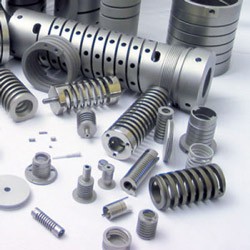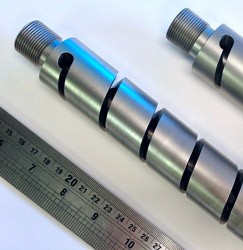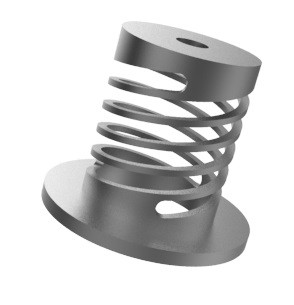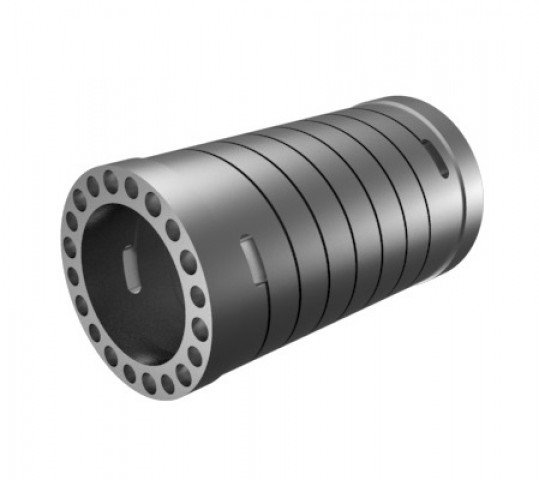Design engineers are discovering the many benefits that machined springs provide to their designs, where spring forces are required. Developed from the concept of incorporating the versatile Heli-Cal Flexure concept into a single piece of material; providing machined springs was a natural leap and over the years has developed into a world class source of precision compression, extension, torsion, lateral bending and lateral translation springs. Machined springs have successfully been used in a wide range of industries such industries as aerospace, medical, defence and renewable energy and continue to be used in ever increasing diversification. The product has been widely used to solve the simplest to the most difficult applications.
The ability to integrate multiple features into a machined spring is another significant benefit. Designers can choose to integrate flanges, geometric shapes (squares, hexagons, spigots, etc), bearing seats, valve seats, gears, splines, bell-crank arms, internal and external threads, and other machinable shapes. The incorporation of these features into a single-piece component reduces the number of parts needed in an assembly and simplifies installation. In the case of torsion springs, integrated attachment features enable the transmission of a pure moment, which avoids many of the drawbacks associated with traditional wire wound torsion springs. Application engineers are ready to assist in the design of a machined spring to customers' specific requirements. Because machined springs are always manufactured for a specific application and purpose, there are no stock machined springs, but means that every spring supplied is identical in terms of performance rate. In fact all machined springs can be calibrated and certified to ensure a tight spring rate tolerance unequalled by its wire wound cousin.
Applied to either high-precision applications or commercially graded needs, the versatile machined spring provides superior elastic performance in a wide variety of applications. Machined springs can be designed to specifically address requirements for rate, reactions at desired deflections, combined rates, modal properties, weight, inertial limits, and more. This application-specific approach facilitates an unusually good correspondence between what is desired and what is economically possible. Helical springs can also support such design objectives as reliability, repeatability and multiple part integration.
Unmatched parallelism during compression and extension
Machined springs provide axial spring rates that are accurate and linear in their feedback because of the absence of residual stresses often associated with traditional wire wound springs. Uniquely, a significant advantage of the machined spring is in its ability to incorporate multiple-start spring coil configurations. Using the multi-start configuration (normally double or triple start) the unresolved moments common to single-start springs will work to inhibit tipping of the spring during compression or extension. One additional benefit of the multi-start coil configuration is that it also provides a level of system redundancy, because more than one coil is transmitting the load.
Another possibility with machined springs is combining a right-hand and left-hand springs in a single piece to prevent the rotation under load, something that many types of wire wound springs exhibit during compression and extension. The ability to incorporate custom machined features as part of a single-piece elastic component makes machined spring an excellent choice for demanding applications.
Torsion Springs can incorporate innovative tang designs
Endless design options are possible with machined springs when applied to torsional load cases. Because attachment features can be integrated into a single-piece machined spring, the traditional challenges of how to transfer torque into a torsion spring are no longer a concern. It is now easier to use the versatility of integrated features to enable a pure moment to be created in the torsion spring application. With linear rates and the potential for rate accuracies approaching one per cent, outstanding performance from machined springs can raise the product design above alternatives.
Lateral bending and translation springs
Additional benefits of machined springs can be realised in applications beyond the normal compression/extension or torsion load cases. The second to none engineering staff can apply their expertise in engineered elasticity to spring designs involving lateral bending and/or lateral translation applications. Lateral bending is the result of anchoring at one end and applying a moment to the opposite end. Lateral translation occurs when one end of the spring is anchored and the other end has a force and moment applied in such a way that the ends remain parallel during displacement.
Leveraging the machined spring's ability to provide both predetermined elastic performance and integrated attachment features, all in a single-piece component, enables designers to benefit from significant advantages, all backed by the reliable and repeatable performance for which Abssac is renowned. The integrated attachments facilitate the anchoring of the spring and subsequent application of forces and/or moments with unprecedented ease. Changing the outside or inside diameters, as well as the number of starts, number of coils and coil width, make it is possible to provide the desired spring rates in different axes of displacement.
Follow the link for more information about machined springs. Abssac is currently offering a free demo box for engineers who wish to find out more about this unique product.


Abssac has recently supplied a set of machined springs to customer measuring a compressive/tensile load of over 22kN in a very constrained spatial envelope. Oil and gas exploration applications are, in many ways, similar to those involving equipment destined for the planet Mars: it is in a place that is inaccessible, toxic and has a corrosive environment; a place where equipment failures cannot be tolerated.
This is exactly why Abssac is having great success with its machined spring product because of its performance characteristics and proven reliability. In many of the applications within this industry a spring system is required to accurately store energy, deliver a constant force, accurately measure for deflection or perhaps act as a fail-safe component.
Wire wound springs are often used for these applications, incorporating brazed end attachments such as tangs or ground captivated end seats. In each case a single spring coil is utilised and, by the nature of the wound wire design, they have some performance limitations.
The possibilities are endless with machined springs
Abssac has had many decades of experience supplying its alternative to the wire wound spring. By taking a spring design that has been subjected to FEA (finite element analysis), and machining this form into a solid piece of material, it is possible to create compression, single-piece extension, torsion and lateral springs that have very predictable and accurate performance characteristics. The machined spring can deliver a predicated linear force in any of the spring formats. In some cases, and depending on the geometry of the spring design, the tolerance on the spring rate can be as good as +/-1 per cent. Since the parts are machined, it is then simple to incorporate end attachments into the design, which can permit pure moment attachment.
Most importantly, the machined spring product can offer multi-start springs within the single-piece spring component. Offering single-, double- and triple-start configurations as standard, the product delivers exceptional performance characteristics that are unobtainable by using wire wound springs. For example, in compression, a double- or triple-start spring significantly unifies the lateral bending and lateral translation forces and moments around the spring's circumference given a lateral deflection. In the torsional mode, the machined spring can allow pure moment attachment, by incorporating specific end attachments into the single-piece design. When using integral tangs, the machined spring is without the relative stresses this type of connection can harbour. Offering a choice of materials such as stainless steel or titanium, as well as other exotic alloys, adds strength to the argument that machined springs are a formidable product that can be used where reliability and performance are paramount.
One application called for CC445 stainless steel

A recent application called for a machined spring to be used as part of a load measuring system within a down hole tool for the oil and gas industry. The requirement was to measure a 22,241N (5000lb) compressive/tensile load. The maximum operating temperature was 200degC and the springs would be exposed to corrosive bore hole fluids. In addition to coping with this harsh environment, the actual spring would have to perform within a very constrained space envelope that determined the diameter of the spring - though length was not an issue. The final design used three machined springs attached end-to-end to achieve a 10mm deflection for 22,241N (5000lb). The springs are constrained within a tube and the +/-10mm of linear movement is measured with a precision potentiometer.
Test results were more than satisfactory
Samples for test and evaluation were manufactured with a spring coil geometry designed to deliver the compression spring characteristics required. Two materials were used for the test samples, one using a 17-4ph stainless steel providing an axial spring rate of 6370N/mm with a variation on rate of +/-10 per cent between 0.10mm and 0.60mm compression from free length. This lower load test and rate performance theoretically proved that the required spring performance at the higher loadings would be possible. With the confidence gained from the initial tests, the maximum loading test were then carried out at the customer's premises within a test rig.
At the same time another identical spring was produced using a CC445 stainless steel, which provided the same rate and performance of +/-10 per cent, but this was to be used to compare spring rate tolerance over time in a higher-yield material. In each case the spring design incorporated a thread turned on one end and a tapped hole at the opposite end so the three springs could be assembled together to form a the final single spring system, with a total length of 650mm.
Peter Wright at Abssac recently said that "Whether it is a new spring application or an enhancement of an existing spring design, the machined spring product is relatively unknown by design engineers and yet has so much to offer. Many of our applications are in critical application areas where reliability, and longevity of performance are requisites."
Follow the link for more information about machined springs from Abssac or give Peter a call on 01386 421005
Latest machine spring video can be seen here







